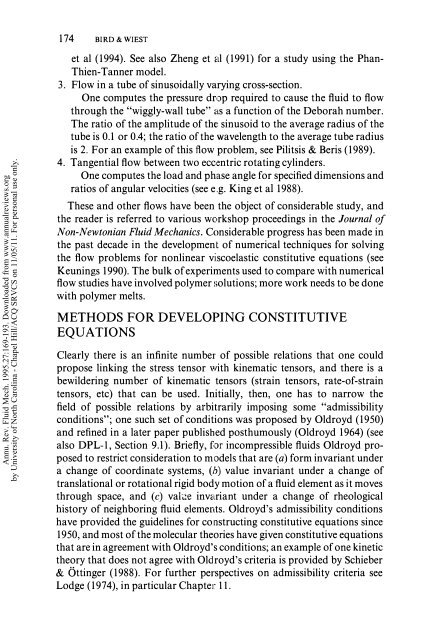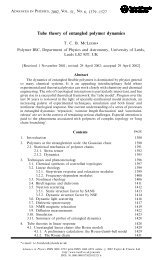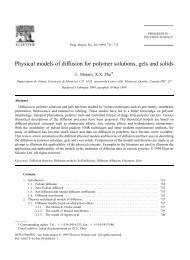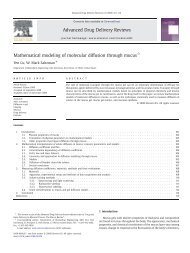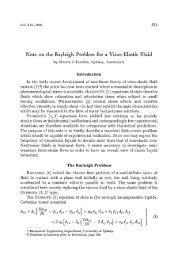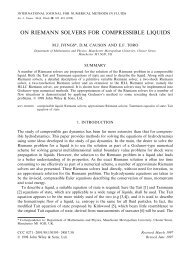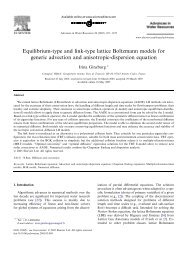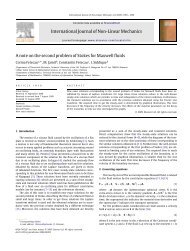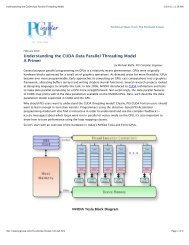Constitutive Equations for Polymeric Liquids
Constitutive Equations for Polymeric Liquids
Constitutive Equations for Polymeric Liquids
Create successful ePaper yourself
Turn your PDF publications into a flip-book with our unique Google optimized e-Paper software.
174 BIRD & WIESTAnnu. Rev. Fluid Mech. 1995.27:169-193. Downloaded from www.annualreviews.orgby University of North Carolina - Chapel Hill/ACQ SRVCS on 11/05/11. For personal use only.et al (1994). See also Zheng et al (1991) <strong>for</strong> a study using the PhanThien-Tanner model.3. Flow in a tube of sinusoidally varying cross-section.One computes the pressure drop required to cause the fluid to flowthrough the "wiggly-wall tube" as a function of the Deborah number.The ratio of the amplitude of the sinusoid to the average radius of thetube is 0.1 or 0.4; the ratio of the wavelength to the average tube radiusis 2. For an example of this flow problem, see Pilitsis & Beris (1989).4. Tangential flow between two eccentric rotating cylinders.One computes the load and phase angle <strong>for</strong> specified dimensions andratios of angular velocities (see e,g. King et aI1988).These and other flows have been the object of considerable study, andthe reader is referred to various workshop proceedings in the Journal ofNon-Newtonian Fluid Mechanics. Considerable progress has been made inthe past decade in the development of numerical techniques <strong>for</strong> solvingthe flow problems <strong>for</strong> nonlinear viscoelastic constitutive equations (seeKeunings 1990). The bulk of experiments used to compare with numericalflow studies have involved polymer solutions; more work needs to be donewith polymer melts.METHODS FOR DEVELOPING CONSTITUTIVEEQUATIONSClearly there is an infinite number of possible relations that one couldpropose linking the stress tensor with kinematic tensors, and there is abewildering number of kinematic tensors (strain tensors, rate-of-straintensors, etc) that can be used. Initially, then, one has to narrow thefield of possible relations by arbitrarily imposing some "admissibilityconditions"; one such set of conditions was proposed by Oldroyd (1950)and refined in a later paper published posthumously (Oldroyd 1964) (seealso DPL-I, Section 9.1). Briefly, <strong>for</strong> incompressible fluids Oldroyd proposedto restrict consideration to models that are (a) <strong>for</strong>m invariant undera change of coordinate systems, (b) value invariant under a change oftranslational or rotational rigid body motion of a fluid element as it movesthrough space, and (c) vake invariant under a change of rheologicalhistory of neighboring fluid elements. Oldroyd's admissibility conditionshave provided the guidelines <strong>for</strong> constructing constitutive equations since1950, and most of the molecular theories have given constitutive equationsthat are in agreement with Oldroyd's conditions; an example of one kinetictheory that does not agree with Oldroyd's criteria is provided by Schieber& Ottinger (1988). For further perspectives on admissibility criteria seeLodge (1974), in particular Chapter II.


